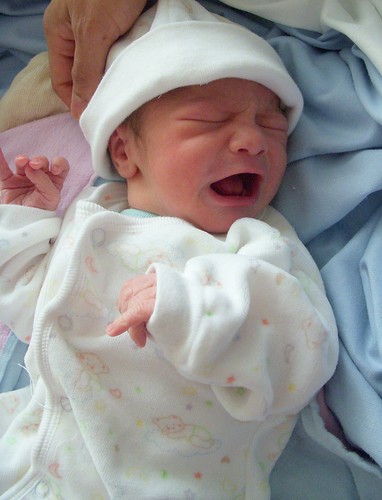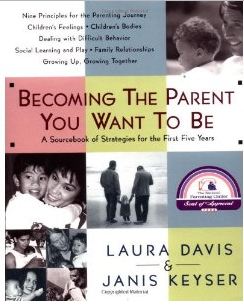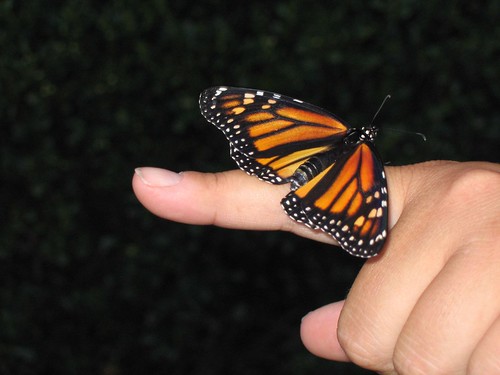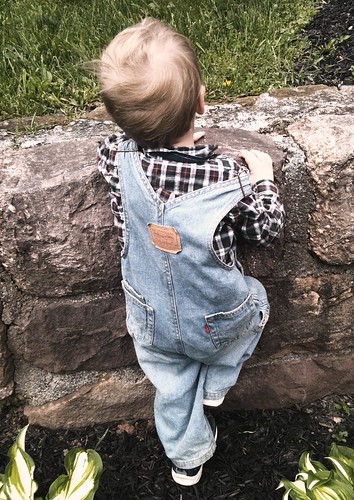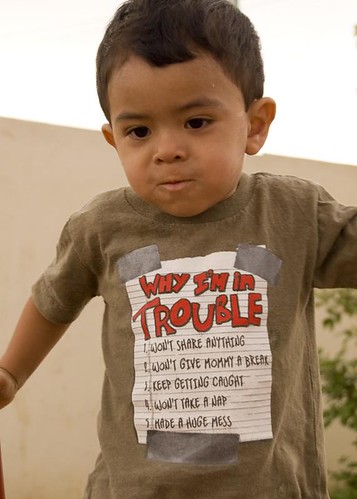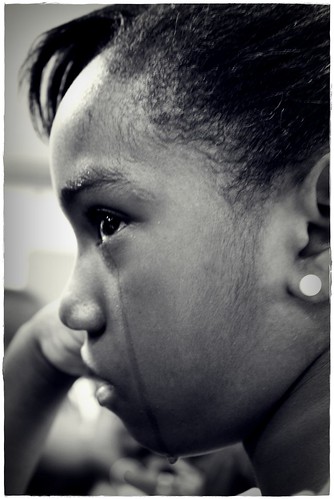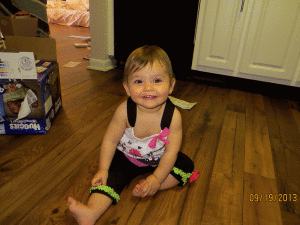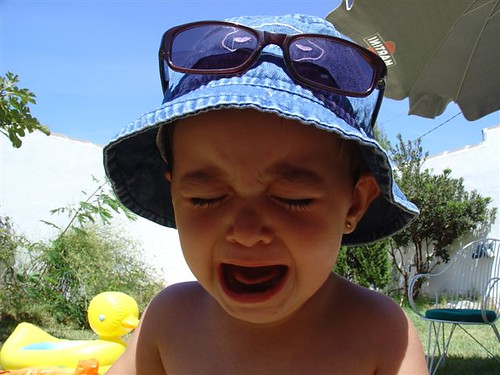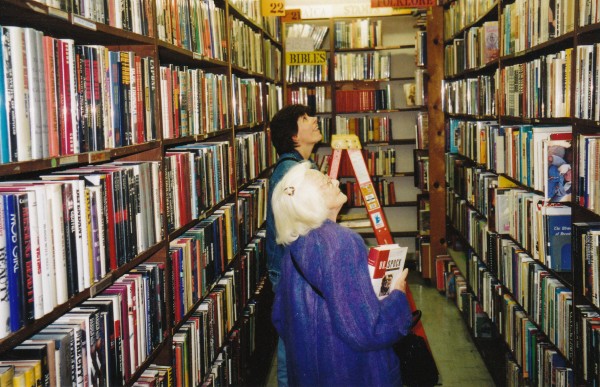Is it just possible that the Happiest Baby On The Block is the most oppressed? If a parent responds to a baby’s cries as Doctor Harvey Karp suggests, from her earliest moments, the baby may be getting the message that her cries won’t be tolerated or taken seriously. I know this is absolutely the last message in the world that loving, caring parents intend to send to their babies, which is why I have a difficult time tolerating it when professionals package and sell programs to unsuspecting and vulnerable parents who only want to understand and offer comfort to their babies.
Consider: What messages might a baby be receiving if we respond to their cries in the way Doctor Harvey Karp demonstrates in this video?
https://youtube.com/watch?v=guRi6zyFHtwframeborder%3D0allowfullscreen
Doctor Karp teaches new parents to “recreate the conditions of the womb” in order to comfort and quiet babies through using a method he refers to as the “5 S’s“:
- Tight Swaddling: Karp says, “Tight swaddling provides the continuous touching and support your baby is used to experiencing within the womb.” ( I don’t recommend tight swaddling because I believe babies need and deserve to be free to move their arms and legs, which is one of the ways they discharge energy. Additionally, tight swaddling can cause or aggravate existing hip problems. A better alternative is a sleep sack.)
- Side/stomach position: “The infant is placed on their left side to assist in digestion, or on their stomach to provide reassuring support. “But never use the stomach position for putting your baby to sleep,” cautions Karp. Sudden Infant Death Syndrome (SIDS) is linked to stomach-down sleep positions. When a baby is in a stomach down position do not leave them even for a moment.” ( I’ve written about the drawbacks of placing babies on their stomachs before they can move into this position independently. It’s not worth the risk to your baby’s health, development, or safety to place her into a side or stomach position in the hopes that it will stop her crying.)
- Shushing sounds: “These imitate the continual whooshing sound made by the blood flowing through arteries near the womb.” ( I don’t believe loudly shushing a baby sends the message that I’m present, available, and listening.)
- Swinging: Newborns are used to the swinging motions within their mother’s womb, so entering the gravity driven world of the outside is like a sailor adapting to land after nine months at sea. “It’s disorienting and unnatural,” says Karp. Rocking, car rides, and other swinging movements all can help. ( Babies quickly get used to and become dependent on rocking, car rides, bouncing, or swinging to lull them and to put them to sleep, and then come to need these things. I believe it best to comfort babies with a minimum amount of movement. Rocking, swaying, or walking with a crying baby is often comforting for the adult, but I’d avoid taking the baby for car rides in the hopes of quieting them. Magda Gerber suggested, “All the many forms of what we call comforting, bouncing a child on one’s knee or rocking her in a rocking chair, often express our own nervous energy and frustration when confronted with a crying baby.”)
- Sucking: “Sucking has its effects deep within the nervous system,” notes Karp, “and triggers the calming reflex and releases natural chemicals within the brain.” (It’s true that babies derive comfort from sucking, but they find their hands or thumbs quickly when given an opportunity.)
Karp suggests using these “techniques” in the first weeks and months of a baby’s life, and all at once! I don’t know about you, but I didn’t observe that baby Maya was comforted by having the “5 S’s” administered. To my eyes, she appeared to be shocked into silence. Not only that, but she was being “handled” and manipulated as if she was an object, not a human being. In fact, when I viewed the video for the first time, I didn’t realize that Doctor Karp was “using” an actual baby to “demonstrate” his method- I thought he was shaking a doll. I heard Janet Lansbury’s gentle admonishment, “If you wouldn’t want it done to you, don’t do it to your baby. In fact, don’t do things to your baby, do things with your baby.”
Even more upsetting and insulting, Maya is being talked about as if she’s not there, as Karp goes on to advise the trusting mom how to “trick” her baby into holding onto the pacifier, by “pretending” to pull it away from her. When he asks Mom if Maya might be hungry, and the reply is “Yes,” he allows that it’s natural for Maya to be fussy, and “If you were at home and not doing a little class, you’d feed her.” So- the baby is expressing a need, and the mother is understanding the baby’s communication, and the good doctor advises the mom to ignore her baby’s communication in the interest of continuing to demonstrate how well his calming technique works- for the cameras and all the world to see.
Again I ask, what message is Maya receiving? Wouldn’t it be better to help mom and baby to build their relationship by encouraging mom to listen, respond to, and honor Maya’s expressed need to eat? I would have been less incensed had Dr. Karp at least acknowledged or talked to the baby about what was happening. The infant was completely left out of the equation here.
Another difficulty I have with programs like Dr. Karp’s, which are meant to teach parents to “magically” stop a baby’s crying, is that they set up unrealistic expectations for parents. All soothing “strategies” may work some of the time, but nothing works all of the time.
This should not be a surprise; after all, babies are not machines, and do not act like machines. The problem is, of course, that programs that claim to be successful, especially when you “do it right,” can raise expectations that you should be able to soothe your infant. Then, if you can’t, and the infant continues to cry, you can feel even worse than you felt from the crying alone, because you have now “failed” somehow. The saddest thing is to hear about parents who say, even when they have done all the things they were promised would work, but their baby keeps crying, “I feel like such a failure.” Ronald G. Barr, MDCM, FRCP(C)
“Many babies cry a lot during the first weeks, even the first three months. There can be several reasons; most likely the premature organism does not yet function smoothly and babies have to learn to adapt to a very different life from the one that they were accustomed to in the womb.” Magda Gerber
I believe babies (even the most fragile) are up to the challenge of adapting, thriving, and participating in their own process when given a bit of gentle, calm support. Every effort should be made to understand and respond sensitively to a baby’s cry (which I see as communication), but I do not believe that we should try to (or need to) artificially recreate the conditions of the womb in order to quiet a crying baby.
In fact, quieting a crying baby should never be the goal. I suggest taking a deep breath, slowing and calming yourself before responding. Listen and try to understand why the baby is crying. You might say, “I hear you crying. I wonder what you might be saying?” If there is a need that can be met, like hunger, or the need for sleep, then it makes sense to respond by meeting the need. If baby is crying, and you can’t discern an obvious reason, then it can be helpful to reduce stimulation to a minimum, and just gently hold him, or lie her down. Skin to skin contact, gently swaying your body while cuddling baby in your arms, talking softly or quietly humming a song, may comfort your baby (or maybe it comforts you), but sometimes, you may find that nothing you do has a calming effect.
What is important for all parents to understand (but especially new parents), is that it is normal and natural for babies to cry. In fact, this is what is sometimes referred to as The Period of PURPLE Crying which “begins at about 2 weeks of age and continues until about 3-4 months. There are common characteristics of this phase, or period, which are described by the acronym PURPLE. All babies go through this Period; it is just that during this time some can cry a lot, some far less, but they all do go through it,” writes Marilyn Barr, Founder/Executive Director, NCSBS
I want to help all adults and new parents to understand that each day, newborn babies mature and “settle” a bit more, and that from the very beginning, babies are learning about themselves, about us, and about their world through their interactions with us. Babies are dependent on adults to meet their needs, but this doesn’t mean that they are not conscious human beings. Babies deserve to be treated with dignity and respect, and as partners in relationship from their very first moments.
I’m passionate about helping new parents to understand their babies’ cries, and encouraging them to feel confident in responding in ways that will strengthen and build the relationship and communication between them and their baby. To that end, I’m offering some further resources here, and as always, I welcome all questions and comments.
Period of Purple Crying, A New Way To Understand Your Baby’s Crying
What Is All That Crying About? Ronald G. Barr, MDCM, FRCPC
The Truth About Infant Self Soothing Janet Lansbury
7 Reasons To Calm Down About Babies Crying Janet Lansbury
The Secret Language of Babies Janet Lansbury
It’s Okay to Let Your Baby Cry Gracelings
Babies and Crying: What’s a parent to do? Lisa Sunbury
Soothing Your Baby the Calms Way Parenting With Love
